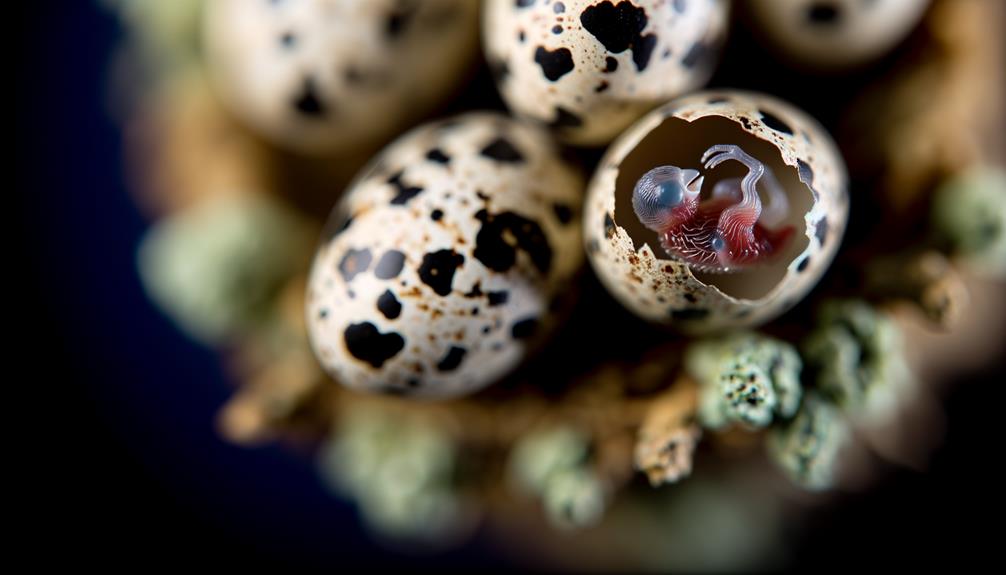Measuring Big Sparrow Eggs: A Guide
Sparrow eggs average between 0.6 and 0.8 inches in length, designed with an oval shape optimized for a favorable surface area to volume ratio. They possess a pale outer shell made of calcium carbonate, often featuring speckled patterns for camouflage.
Weighing approximately 1.5 to 2.5 grams, the thickness of the shell ranges from 0.2 to 0.4 millimeters, facilitating important gas exchange for embryonic development. Factors such as species, environment, and diet variably influence these measurements.
Sparrows in colder climates and areas with abundant food supply tend to produce larger eggs. Further fascinating details await on their ecological impact and survival adaptations.

Key Takeaways
- Sparrow eggs measure between 0.6 to 0.8 inches in length.
- The average weight of sparrow eggs ranges from 1.5 to 2.5 grams.
- Their shells are thin, 0.2 to 0.4 millimeters, allowing gas exchange.
- Eggs are oval-shaped and have an efficient surface area to volume ratio.
- The eggshell color is typically white to light gray with speckled patterns.
Average Size of Sparrow Eggs

On average, sparrow eggs measure approximately 0.6 to 0.8 inches (1.5 to 2 centimeters) in length. These dimensions reflect a well-adapted reproductive strategy for small passerine birds.
The eggs exhibit an oval shape, providing efficient surface area to volume ratio, which aids in effective heat transfer during incubation.
Typically, the outer shell is pale, often speckled with fine markings, which serve as camouflage against potential predators. The eggshell's composition, primarily calcium carbonate, ensures structural integrity while allowing gas exchange necessary for embryonic development.
Nesting habits, including choice of concealed locations, further enhance the survival rate of these eggs. Such average size and characteristics are crucial in understanding the reproductive ecology and adaptive strategies of sparrows in various environments.
Variations Among Species
Variations in sparrow egg size are evident across different species and regions, reflecting diverse environmental and genetic factors.
For instance, sparrow species inhabiting colder climates tend to produce larger eggs, which may provide better insulation and nutrient reserves for the developing embryo.
Additionally, factors such as food availability and predation pressure play significant roles in influencing the size of sparrow eggs within and among species.
Size Differences by Region
Although sparrows are a diverse group of birds found across various geographic regions, the size of their eggs exhibits significant differences depending on the species and their specific habitats. These variations are influenced by several factors, including environmental conditions and genetic adaptations.
- House Sparrow (Passer domesticus): Found globally, their eggs typically measure about 2.1 cm in length and 1.5 cm in width.
- Song Sparrow (Melospiza melodia): Mainly found in North America, their eggs are slightly smaller, averaging 1.9 cm in length and 1.4 cm in width.
- Cape Sparrow (Passer melanurus): Native to southern Africa, these sparrows lay eggs averaging 2.3 cm in length and 1.6 cm in width.
Understanding these size differences is vital for ecological and evolutionary studies of sparrow populations.
Influences on Egg Size
Environmental factors and genetic adaptations both play pivotal roles in determining the size of sparrow eggs across different species. Temperature, food availability, and habitat quality influence egg size to a great extent. For instance, sparrows in colder climates often produce larger eggs, possibly as a strategy to enhance offspring survival by providing more initial resources.
Genetic factors also contribute, as evolutionary pressures select for egg size that maximizes reproductive success. For example, species like the House Sparrow (Passer domesticus) have evolved smaller eggs compared to the larger Song Sparrow (Melospiza melodia), reflecting differing ecological niches and survival strategies.
These variations underscore the complex interplay between environmental conditions and genetic heritage in shaping reproductive traits across sparrow species.
Egg Shape and Color

The shape of sparrow eggs is generally elliptical or ovate, while their coloration varies from white to light gray, often speckled with brown or gray spots. These morphological characteristics serve multiple purposes:
- Camouflage: The speckled patterns aid in blending with the natural environment, reducing predation risks.
- Identification: Variations in color and patterning can help parent sparrows identify their own eggs amidst potential brood parasites.
- Thermal Regulation: The lighter coloration reflects sunlight, aiding in temperature regulation within the nest.
Such adaptations are essential for the survival and successful hatching of sparrow chicks.
The specific egg shape optimizes space within the nest and ensures efficient heat distribution during incubation, further enhancing embryonic development.
Shell Thickness
Shell thickness in sparrow eggs plays a critical role in providing structural integrity and protection against environmental stressors and mechanical damage. Typically, the thickness of sparrow eggshells ranges from 0.2 to 0.4 millimeters, depending on various factors such as species, diet, and environmental conditions. The shell is primarily composed of calcium carbonate, providing the necessary rigidity while allowing gas exchange through microscopic pores.
| Measurement Aspect | Value Range | Units |
|---|---|---|
| Shell Thickness | 0.2 – 0.4 | millimeters |
| Calcium Carbonate | 95-97 | percentage |
| Pore Density | 300-400 | pores/cm² |
Understanding these parameters is essential for avian biologists and ecologists to gauge the reproductive health and adaptability of sparrows in diverse habitats.
Weight of Sparrow Eggs

Weighing typically between 1.5 to 2.5 grams, sparrow eggs exhibit significant variability influenced by factors such as species, diet, and environmental conditions. The weight of these eggs is an essential metric in avian biology, reflecting the health and reproductive strategies of sparrows.
Several factors contribute to this variability:
- Species Differences: Different sparrow species lay eggs of varying weights, impacted by genetic and ecological adaptations.
- Dietary Intake: The nutritional quality of the mother's diet directly affects the egg's weight, with better nutrition leading to heavier eggs.
- Environmental Conditions: Factors such as temperature and humidity can influence egg weight, as they affect the developmental environment of the embryo.
These elements collectively determine the precise weight of sparrow eggs.
Comparison to Other Birds
Understanding the weight of sparrow eggs in relation to other bird species provides insightful context into avian reproductive strategies and ecological adaptations. Sparrow eggs typically weigh between 1.5 to 2 grams, placing them on the smaller end of the spectrum within the avian world.
In contrast, larger bird species such as chickens (Gallus gallus domesticus) produce eggs that weigh approximately 50 grams, while even smaller birds like hummingbirds (Trochilidae) lay eggs weighing a mere 0.4 grams. This variation in egg size reflects different ecological niches and reproductive strategies.
Smaller eggs, such as those of sparrows, generally correspond to shorter incubation periods and higher reproductive rates, allowing these birds to rapidly adapt to changing environmental conditions.
Factors Influencing Size

Several intrinsic and extrinsic factors contribute to the size of sparrow eggs, encompassing genetic predispositions, nutritional availability, environmental conditions, and parental investment strategies.
To begin with, genetic predispositions affect egg size through inherited traits, leading to variations across different sparrow species and even within populations.
Next, nutritional availability plays a pivotal role; sparrows with access to abundant, nutrient-rich food sources typically produce larger eggs.
Environmental conditions such as temperature and habitat quality influence egg size, with harsher environments often resulting in smaller eggs due to increased energy demands on the parents.
These three factors:
- Genetic predispositions
- Nutritional availability
- Environmental conditions
interact complexly, determining the ultimate size of sparrow eggs, reflecting evolutionary adaptations and ecological constraints.
Nesting Habits and Egg Size
Nesting habits greatly influence the size of sparrow eggs, as the choice of nest location, structure, and materials can affect thermal regulation, predation risk, and parental resource allocation. Sparrows typically select well-concealed locations to mitigate environmental stressors. Nest structure, often composed of grasses, feathers, and twigs, provides insulation, which is crucial for maintaining optimal egg temperature. The materials used not only enhance thermal regulation but also impact the nest's durability and protection against predators. Parental investment in nest construction and maintenance directly correlates with egg size, as better-protected nests enable parents to allocate more resources to egg production.
| Nest Location | Materials Used | Average Egg Size (mm) |
|---|---|---|
| Urban Structures | Feathers, paper, twigs | 20.5 |
| Bushes and Shrubs | Grass, leaves, feathers | 19.8 |
| Tree Branches | Twigs, moss, hair | 20.1 |
| Ground Nests | Grass, leaves, feathers | 19.5 |
| Artificial Nesting | Paper, synthetic fibers | 20.3 |
Development Inside the Egg

The embryonic development of sparrows within the egg is a meticulously orchestrated process that involves a series of well-defined stages, from initial cell division to the formation of vital physiological systems. During this intricate process, several key developmental milestones are achieved:
- Cleavage and Blastulation: Post-fertilization, the zygote undergoes rapid cell division, forming a blastula, a hollow sphere of cells.
- Gastrulation: The blastula reorganizes into a multi-layered structure called the gastrula, establishing the primary germ layers: ectoderm, mesoderm, and endoderm.
- Organogenesis: These germ layers differentiate into essential organs and tissues, including the heart, brain, and digestive system.
These stages are essential for ensuring that the embryo develops properly, culminating in the hatching of a fully formed sparrow chick.
Survival Rates of Sparrow Eggs
Understanding the survival rates of sparrow eggs requires a thorough examination of various biotic and abiotic factors that influence embryonic viability and successful hatching.
Key biotic factors include predation, parental behavior, and interspecies competition. Predation by birds, mammals, and insects greatly reduces egg survival. Parental behavior, such as incubation consistency and nest site selection, also plays a crucial role.
Abiotic factors encompass temperature fluctuations, humidity levels, and habitat quality. Extreme temperatures and irregular humidity can disrupt embryonic development. Additionally, habitat degradation reduces the availability of suitable nesting sites, further impacting survival rates.
Consequently, a detailed understanding of these elements is essential for evaluating and improving the reproductive success of sparrow populations.
Human Impact on Sparrow Eggs

Human activities have a substantial impact on sparrow eggs through habitat destruction and pollution, leading to detrimental effects on egg size and health.
Habitat destruction reduces the availability of nesting sites, thereby affecting the reproductive success of sparrows.
Additionally, pollutants such as heavy metals and pesticides can compromise egg integrity and embryonic development, posing serious risks to the overall sparrow population.
Habitat Destruction Effects
Encroachment on natural habitats by urban development greatly influences the size and viability of sparrow eggs. Habitat destruction disrupts breeding grounds and alters the availability of nesting materials.
Scientific observations indicate several critical impacts:
- Nutritional Deficiency: Reduced access to diverse food sources impacts female sparrows' nutrition, leading to smaller, less viable eggs.
- Stress Factors: Increased human activity and noise pollution elevate stress levels in sparrows, adversely affecting reproductive success and egg quality.
- Predation and Safety: Urban environments expose nests to higher predation risks, forcing sparrows to nest in suboptimal locations, further impacting egg development.
Understanding these factors underscores the necessity of preserving natural habitats to maintain the ecological balance and health of sparrow populations.
Pollution and Egg Health
Pollution, particularly from heavy metals and pesticides, seeps into sparrow habitats and accumulates in their systems, leading to significant declines in egg health and hatchability. Chronic exposure to contaminants like lead, cadmium, and organophosphates disrupts endocrine functions, resulting in thinner eggshells and reduced embryonic development.
Studies have demonstrated that elevated concentrations of these pollutants correlate with increased egg mortality and deformities. Additionally, bioaccumulation of persistent organic pollutants (POPs) in sparrows can cause oxidative stress, impairing reproductive success.
Environmental contaminants also interfere with calcium metabolism, essential for eggshell formation. Consequently, the integrity of sparrow eggs is compromised, posing a significant threat to population sustainability. Addressing pollution is vital to mitigate these adverse effects on sparrow egg viability and overall species health.
Conclusion
To wrap up, sparrow eggs display notable diversity in size, shape, and color among various species.
For example, the typical egg dimensions of the House Sparrow (Passer domesticus) are roughly 2.1 centimeters long and 1.5 centimeters wide, weighing approximately 2.7 grams. These eggs also showcase varying shell thicknesses and growth patterns.
Notably, only about 60% of sparrow eggs successfully hatch, underscoring the difficulties encountered in the initial phases of bird reproduction.






